
What is a Tub Surround: How to Choose a Tub Surround For Your Bathroom
After purchasing a new bathtub or even sprucing up an existing bath space, you may find that your bathtub doesn’t
Picking out the right bathtub can be quite the daunting choice. Like choosing your first car, there are quite a few things to consider such as your budget and of course the appropriate material for you and your needs. Today, we will be covering just a few of the more common bathtub materials you are likely to encounter and a few of their positives and negatives. Additionally, it’s essential to evaluate the style of the tub and how it fits with your bathroom’s overall decor. Comfort and ease of maintenance are also crucial factors to consider for new tubs, as they can greatly influence your satisfaction over time. Ultimately, the right bathtub should cater to both your practical needs and personal aesthetic.
Bathtubs come in a variety of different options. On the cheap end, you have things such as fiberglass, acrylic and ceramic. These are materials that are fairly porous, meaning they absorb water resulting in more hassle and clean for you. On the other end, you have materials such as stone resin, cast iron, and copper, which are much sturdier and non-porous. They also carry the added benefit of having high heat retention, which makes your bathtub that much more enjoyable. Understanding the components of a bathtub can help you choose the right material for your needs.
| Bathtub material | Price | Stain resistant | Crack resistant | Heat retention | Easy to clean | Easy to install | Weight |
| Fiberglass | $ | No | No | Excellent | Yes | Yes | 70 lbs |
| Porcelain | $ | Yes | Yes | Poor | Yes | Yes | 250 lbs |
| Acrylic | $$ | No | No | Excellent | Yes | Yes | 100 lbs |
| Ceramic | $ | No | No | Poor | Yes | Yes | 320 lbs |
| Stone resin | $$$ | Yes | Yes | Good | Yes | Yes | 400 lbs |
| Cast iron | $$ | Yes | Yes | Excellent | Yes | No | 350-500 lbs |
| Cultured marble | $$ | No | Yes | Good | No | Yes | 300 lbs |
| Copper | $$$ | Yes | Yes | Excellent | Yes | Yes | 500 lbs |
| Wood | $$$ | Yes | Yes | Poor | Yes | No | 400 lbs |
Here are the pros and cons of the most common bathtub materials; jump to the specific material below:
What is it: Fiberglass is a kind of reinforced plastic which is formed into layers then molded into a bathtub shape before being coated with a layer of gelcoat resin.
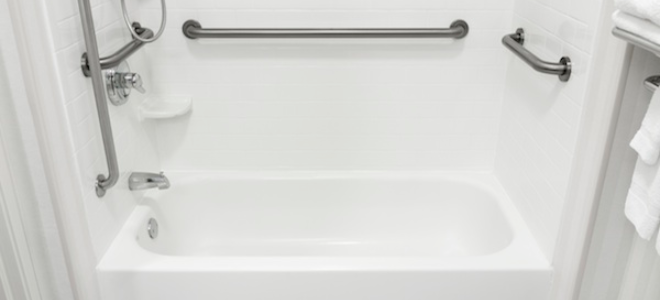
Pros: At very affordable prices, fiberglass tubs are good for those on a tight budget. Due to the lightweight nature of the material used, they are also easy to maneuver around a house and install, plus, any damages can be easily be repaired.
Cons: Fiberglass is also perhaps the most brittle material on the market. Porous in nature, it absorbs water regularly and has a tendency to crack. Color and finish will also deteriorate over time due to the use of common cleaning equipment.The material also has a tendency to ‘flex’ causing it to warp and feel unstable.
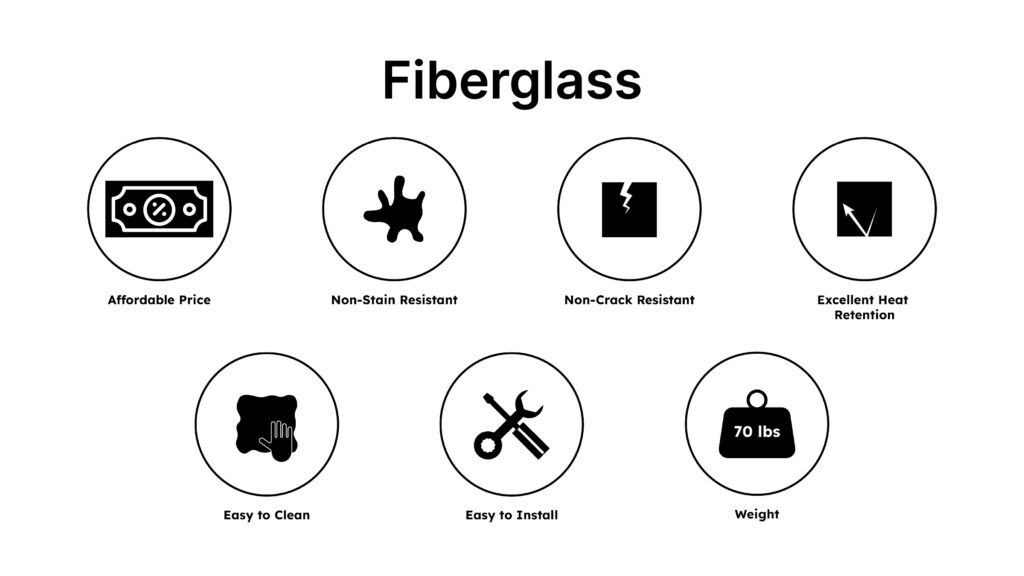
What is it: Porcelain tubs are constructed from cast iron or stamped steel which is then coated with a layer of porcelain enamel-a material made by fusing powdered glass to a thin substrate by heating it at high temperatures, usually between 750 and 850 °C before it melts and hardens into a durable coating.
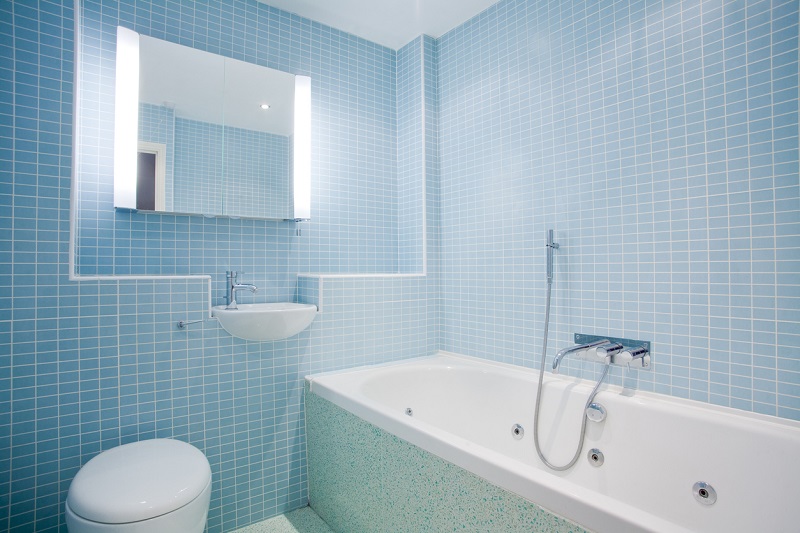
Pros: Porcelain bathtubsmaintain a very nice sheen and luster, and their surfaces are very smooth as well, maintaining an old antique aesthetic. The coating in the tubs are naturally resistant to scratching and cleaning is easy to maintain as a mild detergent or baking soda with warm water will usually knock out any tough stains in a porcelain bathtub.
Cons: Unfortunately for that sheen and luster, porcelain bathtubs are in fact quite slippery, and their surfaces can be quite the falling hazard as a result. Porcelain also does not hold heat very well, resulting in lower heat retention in your bathwater. Durability is also a tricky topic as porcelain is resistant to scratching, but the material itself cannot sustain any hard impacts before chipping. When considering porcelain vs acrylic, it’s important to weigh these factors to determine which material best suits your needs.

| Pros | Cons |
| Smooth surface | Slippery surface |
| Beautiful old antique aesthetic | Doesn’t hold heat well |
| Coating resistant to scratching | Questionable durability |
| Easy to clean and maintain |
What is it: Acrylic is formed by taking a solid sheet of combined materials such as petrochemicals, stabilizers, resins, fillers and appropriate dye which are then heated and molded into a bathtub shape then finally reinforced with fiberglass.
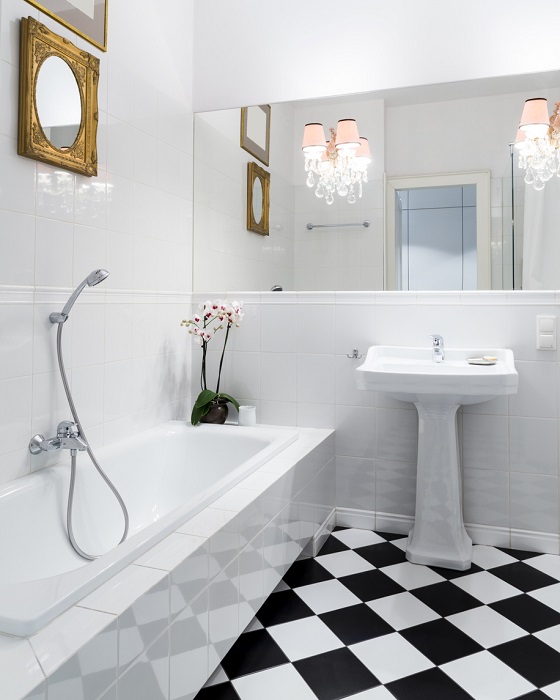
Pros: First and foremost, it is a non-porous material, unlike normal fiberglass and therefore will not absorb any excess water. On top of which, it will also retain heat from the temperature of your water as well as repel any mildew or general bathroom stains.
Cons: Like Fiberglass, Acrylic tubs will also flex, which makes it less stable to stand on and the finish is prone to scratching as well, though not to the quality of fiberglass. You are also looking to pay upwards of eight hundred to a thousand starting, so not a very cheap option.

| Pros | Cons |
| Non-porous material | Doesn’t provide a lot of stability |
| High heat retention | Prone to scratching |
| Easy to clean | Expensive |
What is it: Ceramic bathtubs are created by forming numerous ceramic tiles together, which is essentially clay that is heated to high temperatures until it hardens.
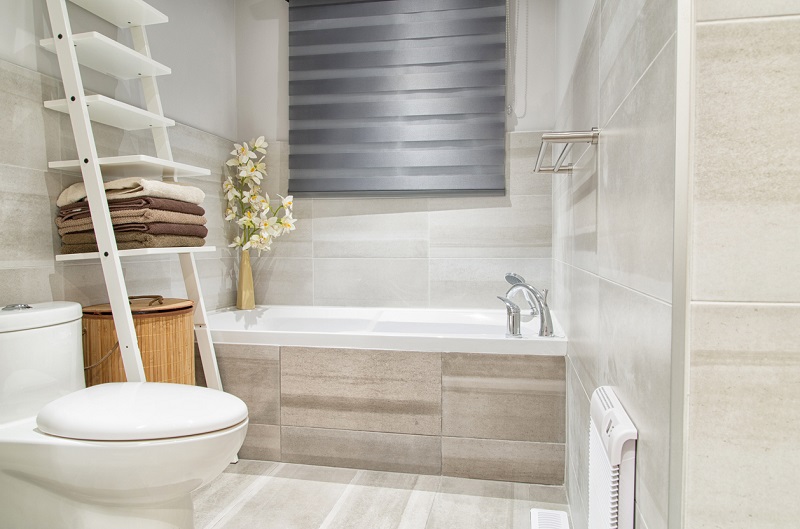
Pros: By far, this material contains the most options for bathtub size, shape and general style as it is very easy to mold and place in your home. It is also fairly cheap as well. Additionally, one of the major advantages of freestanding bathtubs is their ability to serve as a stunning centerpiece in any bathroom, allowing for greater design flexibility. They can be positioned anywhere, making it easier to optimize space and create a more aesthetically pleasing environment. Furthermore, these tubs often provide a luxurious soaking experience, enhancing relaxation and comfort.
Cons: Unfortunately, for the added freedom of choice, you get additional maintenance. You must actively maintain and replace the grout holding the tiles in place or subsequently it will deteriorate and crumble. In addition, due to the makeup of ceramic in general, your bathtub will feel uneven and ‘bumpy’ therefore making it uncomfortable for your bare skin or to lay in.

| Pros | Cons |
| Variety of bathtub sizes, shapes, and styles | Requires active maintenance |
| Affordable | Feel uneven or bumpy |
What is it: Stone resin is a material used to mimic the look of natural stone.
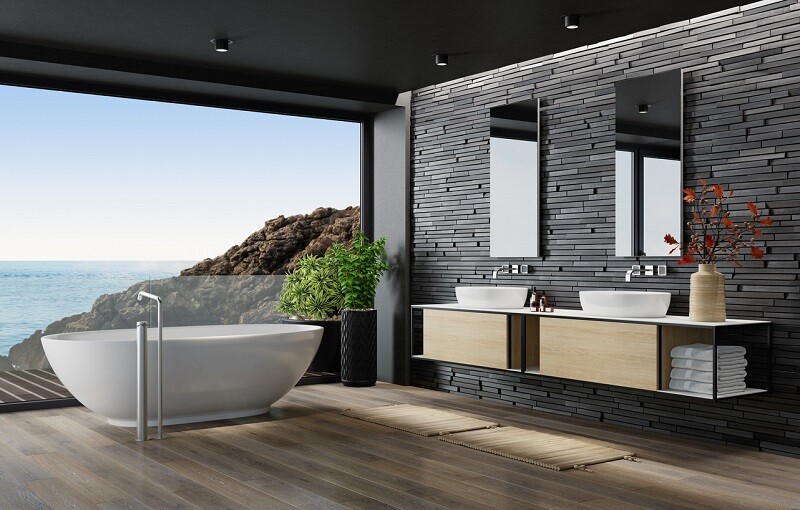
Pros: Like with most resin, color does not fade with repeated water use, the material is non-porous meaning it does not absorb water and retains water heat very well. It has an incredibly long lifespan, lasting for quite some time without the need of constant repair and when it needs to be discarded, stone resin is 100% recyclable. Stone resin is also viewed as a more luxurious bathtub material, not to mention the material itself is quite durable and able to withstand a heavy amount of punishment. Additionally, cleaning is simple and easy. Most stains and mildew will wash away with simple warm water while lightly abrasive substances such as Comet or Ajax can be used for more stubborn residues. Stone Resin is the best bathtub material overall for the price and quality. Request a free stone resin material sample here.
Cons: While it may lie on the more expensive side of things compared to Acrylic or fiberglass, stone resin is able to withstand the test of time and will save you quite a bit of hassle down the road.

| Pros | Cons |
| Non-porous material | One of the most expensive bathtub materials |
| Long lifespan | |
| Color durability | |
| 100% recyclable | |
| Easy to clean |
To feel the quality of stone resin, simply request a free material sample from Badeloft (shown below).
What is it: Molten iron poured directly into a bathtub mold, before it is smoothed out then covered in a layer of enamel.
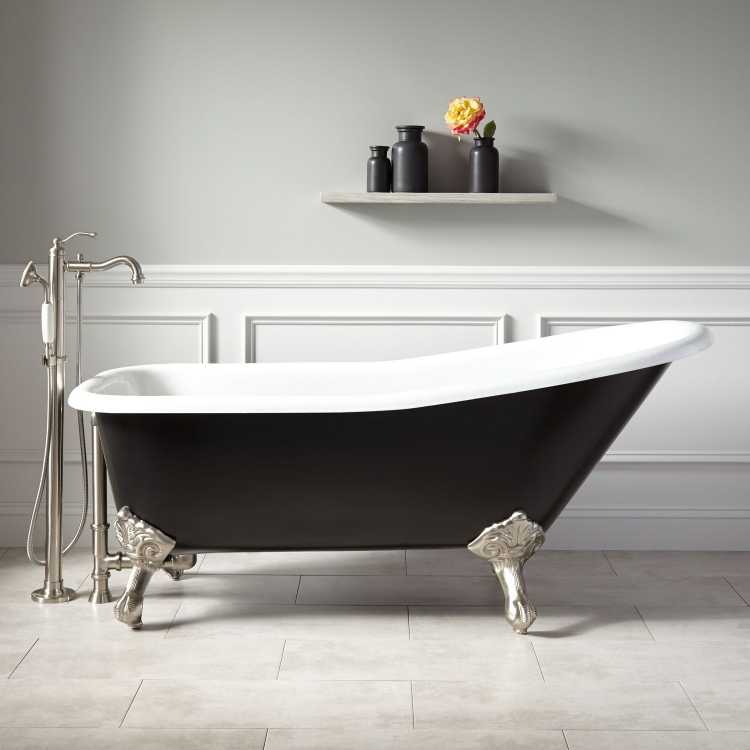
Pros: Cast iron is perhaps the most durable tub on the market. With the strength of the material used, it is highly resistant to scratches and chipping, meaning less care needs to be placed on cleaning as well. Speaking of cleaning, most if not all mildew will wash off with just plain warm water and baking soda, and if something stronger is needed, light cleaning solutions such as Comet can be used, but very rarely are required. Also, cast iron bathtubs have the high heat retention, meaning your bathtub will keep warm for that much longer.
Cons: Durability also means weight. Cast Iron tubs are incredibly heavy, perhaps the heaviest of any tubs on the market currently. The result is that additional considerations must be made to your house and the support structure around the tub before installation. You are also looking at a hefty price, considering the materials involved and the additional work that goes into supporting the space around it.
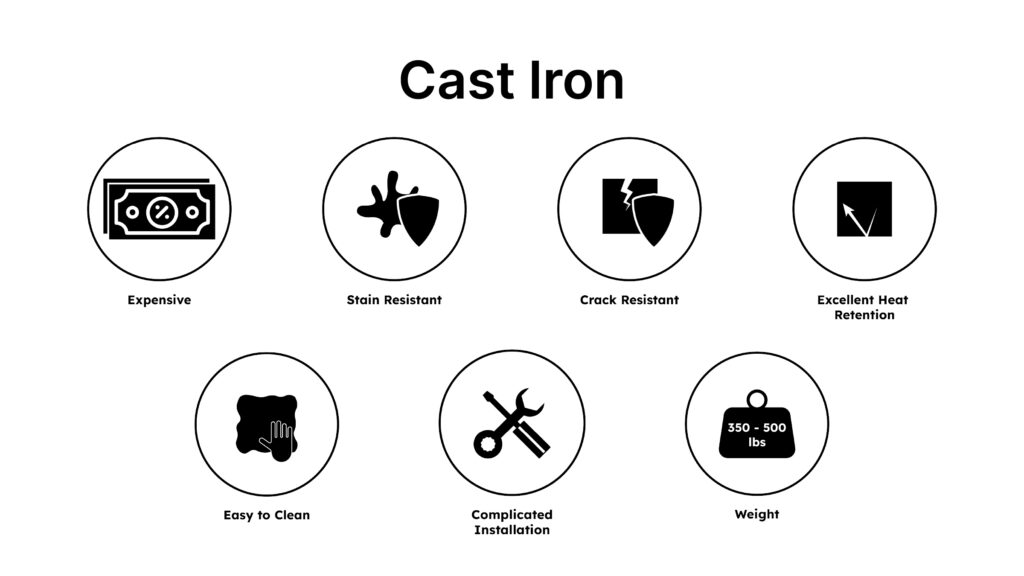
| Pros | Cons |
| Most durable bathtub material | Quite heavy |
| Easy to clean | Requires support structure |
| High heat retention | Expensive |
What is it: Invoking the appeal of the Romans, cultured marble is made from crushed limestone and resin then finished with a layer of gelcoat.
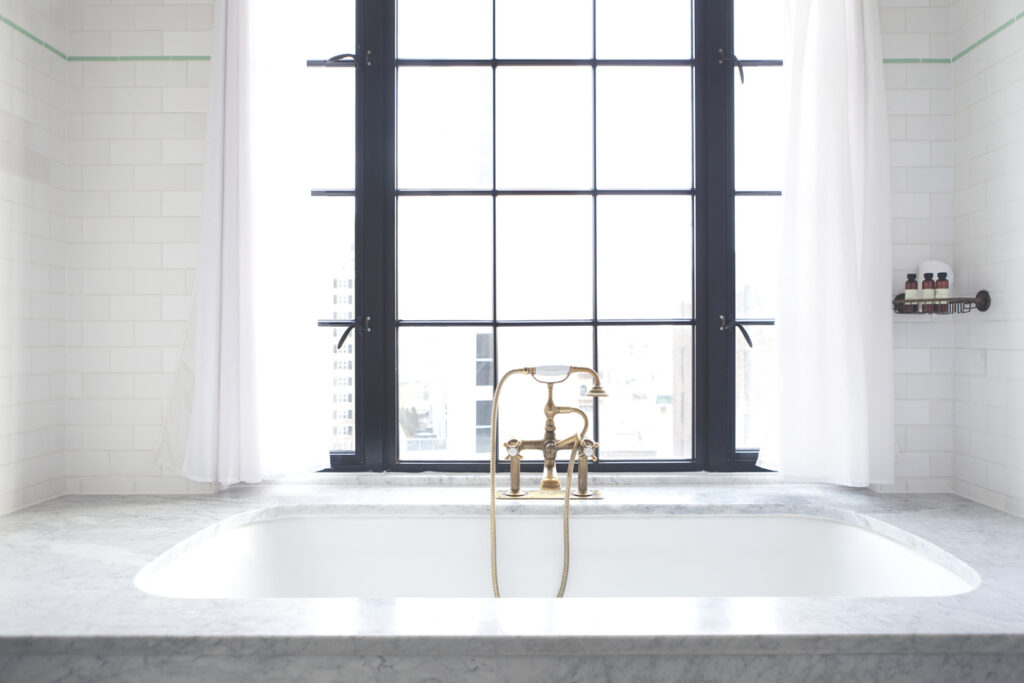
Pros: As with most marble, it retains heat very well while also maintaining an easy, natural look. It also comes in a wide variety of shapes, sizes and color and while not completely scratch resistant, it is quite easy to repair the finish with car wax or other silica products.
Cons: As with most marble, it is quite heavy and with the additional weight, it is also quite expensive. Cleaning is also a bit of a hassle as Cultured Marble requires considerable care. Your bathtub should be cleaned after each use while still wet with a mixture of soap and distilled vinegar. If regular maintenance is not kept up, you are looking at pretty harsh discoloration and mildew build up over time.

| Pros | Cons |
| High heat retention | Quite heavy |
| Variety of bathtub sizes, shapes, and styles | Requires regular maintenance |
| Easy to repair | Expensive |
What is it: Copper bathtubs are made from hammering multiple sheets of pure copper into the shape of a bathtub.
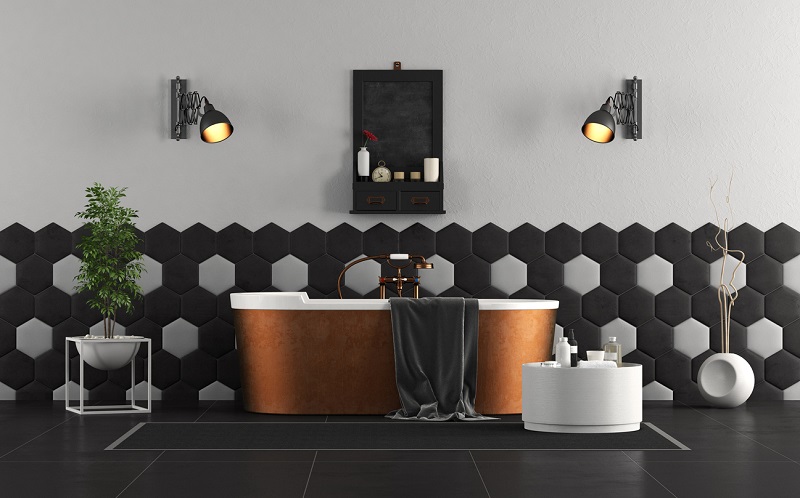
Pros: Similar to a cast iron tub with more of an attractive feel. While also being aesthetically pleasing, a copper tub also maintains good durability, being naturally resistant to scratches and other chipping that may occur. Also, for those who do not enjoy cleaning or maintenance, maintaining a copper tub is very simple and does not require the need of harsh cleaning chemicals whatsoever. Most of the benefits of a copper tub are the aesthetic aspect
Cons: Similar to the cast iron, this tub is also very heavy as well. It is also fairly rare or harder to find than most, making it’s price point one of the highest compared to other bathtubs on the market.
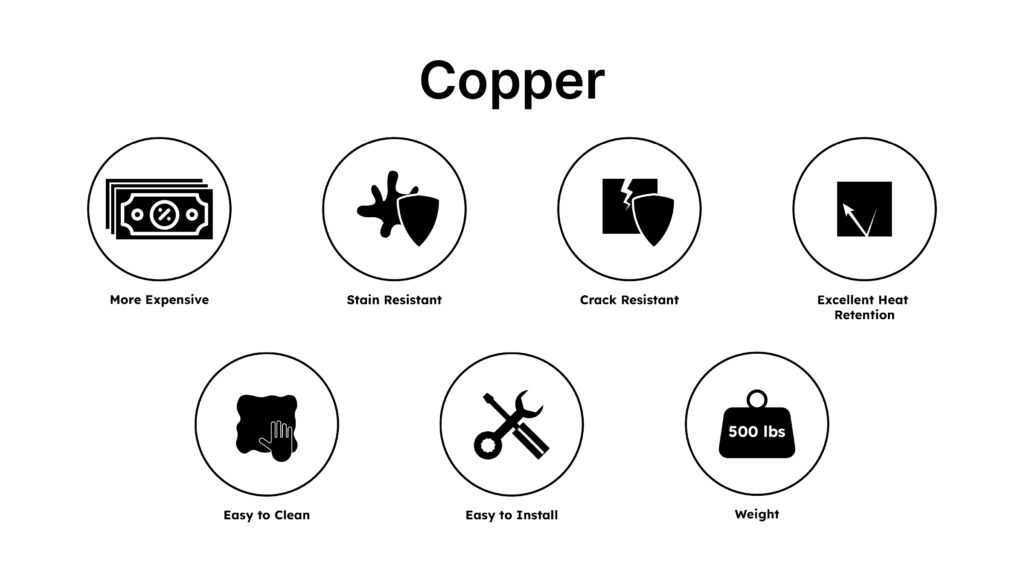
| Pros | Cons |
| Aesthetically pleasing | Quite heavy |
| Good durability | Expensive |
| Easy cleaning and maintenance |
What is it: A custom made bathtub using a variety of different types of wood.
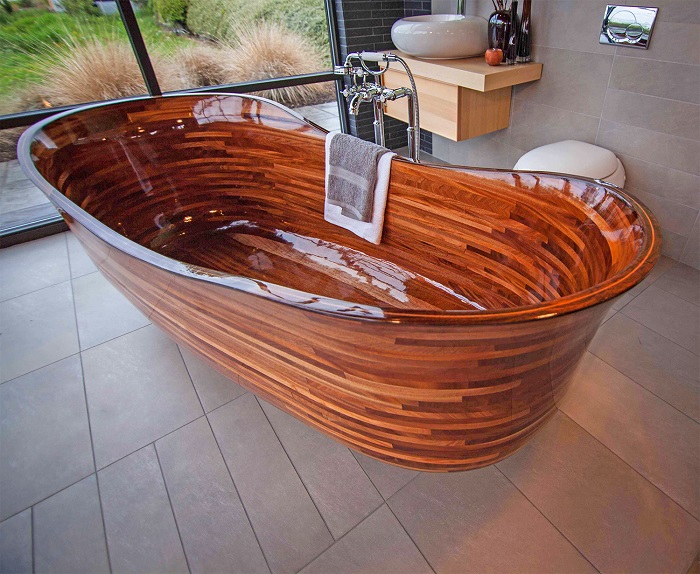
Pros: Aesthetically pleasing with a nice genuine, natural feel to it. Also, since wood is easy to work with, wooden bathtubs can be any shape or size depending on your tastes and does add a certain sense of luxury to your bath time.
Cons: Luxury does come at a heavy price though, as wood in regular contact with water means that your bathtub will not last very long compared to nearly all other bathtubs on the market. Additionally, special considerations must be made in your home to accommodate a wooden tub, such as space and framing. Cost is also a large part of why wooden bathtubs are perhaps not as popular. In addition to the initial cost of the bathtub, regular maintenance must be kept to ensure the longevity of your bathtub. Overuse will invariably wash away the resistant sealing, rotting the wood quicker, while underuse will dry out the wood, speeding up the rotting process. Overall, it is quite a hassle to own a wooden bathtub.
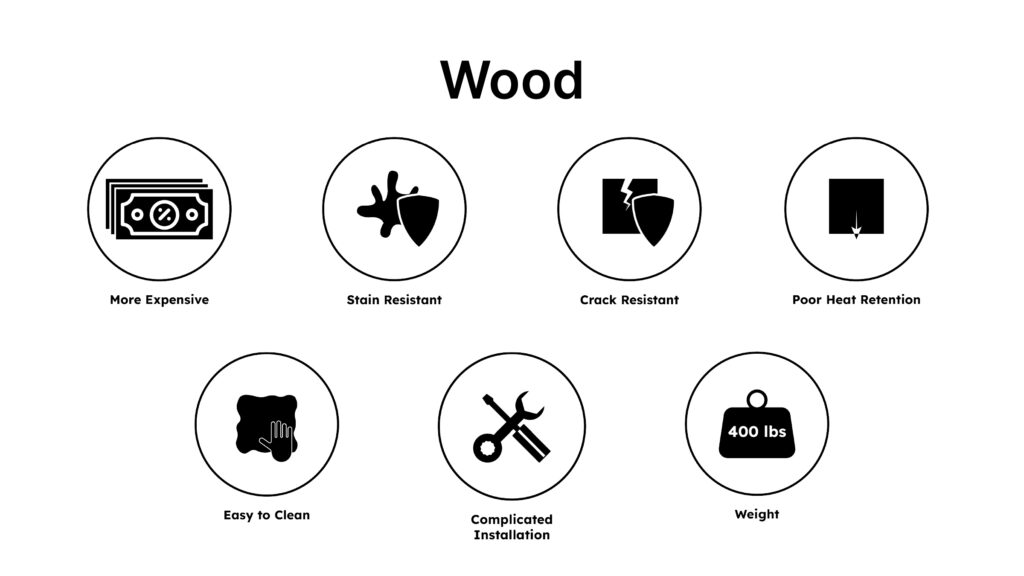
| Pros | Cons |
| Natural look | Requires active maintenance |
| Variety in bathroom shapes and sizes | Expensive |
Bathtub materials have become a defining element of bathroom design, reflecting a shift toward sustainability, tactile comfort, and sculptural form. Homeowners and designers are prioritizing not just how a tub looks, but how it feels and performs over time. In 2025 and beyond, the emphasis is on durability, warmth, and natural materials that turn ordinary spaces into personal retreats.
Stone resin continues to dominate bathtub design for its seamless combination of beauty and practicality. Made from crushed natural stone blended with resin, these bathtubs offer the aesthetic richness of stone with enhanced durability, heat retention, and easy maintenance. They are lighter than traditional stone yet exude the same timeless sophistication, making them ideal for freestanding installations in both large and compact bathrooms.
Acrylic bathtubs remain a favorite among homeowners who value flexibility and affordability. The material’s smooth surface, wide variety of colors and shapes, and lightweight composition make it especially popular for remodels and modern builds. It’s also easy to repair and maintain, ensuring long-term appeal without the higher cost of premium materials.
For those seeking unmatched craftsmanship, natural stone bathtubs are the ultimate statement. Each piece is hand-carved, creating a one-of-a-kind focal point that celebrates organic beauty. Though heavier and more expensive, their raw elegance and exceptional heat retention make them an indulgent choice for spa-inspired spaces.
As biophilic design trends rise, wood and wood-composite tubs are making a comeback. These materials add warmth and natural texture to modern bathrooms, often sealed with water-resistant finishes that maintain integrity over time. They pair especially well with stone resin elements, creating a balance between modern engineering and nature’s authenticity.
The data behind bathtub material preferences paints a clear picture of where the industry is headed. As technology, sustainability, and design sophistication evolve, certain materials are emerging as long-term leaders—while others are being phased out or reserved for niche applications.
Accounts for approximately 38% of premium bathtub installations and continues to rise as eco-conscious design and sculptural freestanding tubs gain traction. Its lightweight yet solid composition appeals to both homeowners and builders seeking luxury without compromise.
Holds about 37% of the market due to its affordability, ease of customization, and adaptability to any bathroom size. It remains the go-to choice for families and remodels seeking durability without the added weight of stone-based materials.
Represents around 15% of total sales. Though budget-friendly, fiberglass tubs are often selected for guest baths or temporary installations, as they are more prone to scratching and fading over time.
Maintains roughly 5% of the market, appealing to those who prioritize traditional charm and durability. However, its weight and installation complexity limit its use in modern high-rise or minimalist spaces.
Holds a modest 3% market share, serving a luxury niche that values exclusivity, craftsmanship, and tactile beauty over convenience or cost.
Make up about 7% of installations. These materials are gaining interest for custom designs, wellness suites, and boutique spa environments, signaling a growing appetite for warmth and individuality.
These trends show a clear trajectory: materials like stone resin and acrylic dominate for their blend of luxury and practicality, while natural and composite finishes are shaping the future of bespoke bathroom design.
When it comes to cost, fiberglass and basic acrylic bathtubs are generally considered the most budget-friendly options on the market. These materials are inexpensive to produce, lightweight, and easy to install, which makes them popular choices for apartment buildings, guest bathrooms, and quick renovations. Fiberglass, in particular, is made from layers of plastic reinforced with glass fibers, keeping production costs low. However, its affordability comes at the expense of long-term durability—fiberglass tubs can scratch, fade, and crack more easily over time, often needing replacement within a decade of heavy use.
Entry-level acrylic tubs also fall into the “cheap” category when made from thinner sheets of acrylic without proper reinforcement. While smoother and more attractive than fiberglass, these tubs are more susceptible to bending, discoloration, and loss of luster with frequent use. The lower cost makes them an accessible choice for short-term housing or budget renovations, but they lack the heat retention, longevity, and premium feel of materials like stone resin or enameled cast iron. In essence, cheap bathtub materials trade long-term performance and craftsmanship for immediate savings—a compromise many homeowners outgrow as they seek more sustainable, lasting, and visually refined designs.
When it comes to the best bathtub material for 2025 and beyond, stone resin stands at the forefront. Its blend of elegance, strength, and sustainability makes it the preferred choice among designers and homeowners alike. Crafted from a mixture of natural stone and resin, it offers the tactile appeal of carved stone without the drawbacks of excessive weight or high maintenance. Stone resin’s ability to retain heat, resist scratches, and maintain a sleek matte or glossy finish ensures it not only looks beautiful but also performs exceptionally well over time. Whether featured in a minimalist ensuite or a luxury spa bathroom, stone resin continues to represent modern craftsmanship and enduring value.
At the same time, wood is experiencing a quiet resurgence, appealing to those who crave warmth and nature-inspired design. While not as common as stone resin, wood bathtubs—often made from teak, hinoki, or sustainably sourced hardwoods—bring organic texture and calming visual contrast to contemporary spaces. With proper sealing and care, these tubs can last for years, offering both comfort and character. As homeowners embrace wellness-driven interiors and biophilic design, pairing wood elements with stone resin tubs or finishes has become a leading trend, uniting natural beauty with modern performance.
Choosing the ideal bathtub material is about more than aesthetics—it’s about creating a bathing experience that aligns with your lifestyle, budget, and design goals. The following tips will help you narrow down the best choice for your space while balancing comfort, maintenance, and long-term value.
Your budget will determine the range of materials available to you. Fiberglass and acrylic provide affordable entry points, while stone resin offers mid-to-high-end luxury with enduring value. Natural stone sits at the top of the range, appealing to homeowners investing in signature, spa-quality spaces.
Heavier materials like natural stone and cast iron may require reinforced flooring. Stone resin, by contrast, provides the same visual impact and durability at a fraction of the weight, making it suitable for most home structures without additional support.
If your bathtub will be used frequently, durability should be a top consideration. Stone resin and enameled cast iron are known for their long lifespans and ability to resist surface wear, ensuring your investment lasts for years with minimal upkeep.
For those who love long, warm soaks, materials like stone resin, cast iron, and natural stone are excellent choices. Their dense composition keeps bathwater warmer for extended periods, enhancing the relaxation experience.
Each material contributes a unique personality to your space. Stone resin complements modern and minimalist interiors, while natural stone and wood finishes suit organic, rustic, or spa-inspired designs. Acrylic can adapt to nearly any aesthetic thanks to its range of shapes and colors.
Maintenance plays a key role in how your bathtub looks over time. Stone resin and acrylic require little more than regular cleaning to maintain their finish. Fiberglass, on the other hand, can dull or stain over time, requiring more frequent upkeep.
Before making a final decision, visit a showroom to experience the materials in person. Sitting in the tub allows you to assess depth, ergonomics, and comfort—ensuring the bathtub suits your body type and complements your bathroom’s layout.
The ideal bathtub material balances artistry, comfort, and practicality. As we move into 2026, stone resin continues to define modern luxury—lightweight, durable, and eco-conscious—while natural textures and smart design trends add warmth and individuality to the bathing experience. Whether you seek spa-level serenity or minimalist elegance, the right material transforms your bathroom into a timeless retreat designed for relaxation and renewal.

Eric is the founder and president of Badeloft USA. He has been the president of Badeloft’s US division for over ten years and oversees all marketing and branding aspects of Badeloftusa.com.
His expertise lies in small business development, sales, and home and bathroom industry trends and information.
Contact us with any business related inquiries.
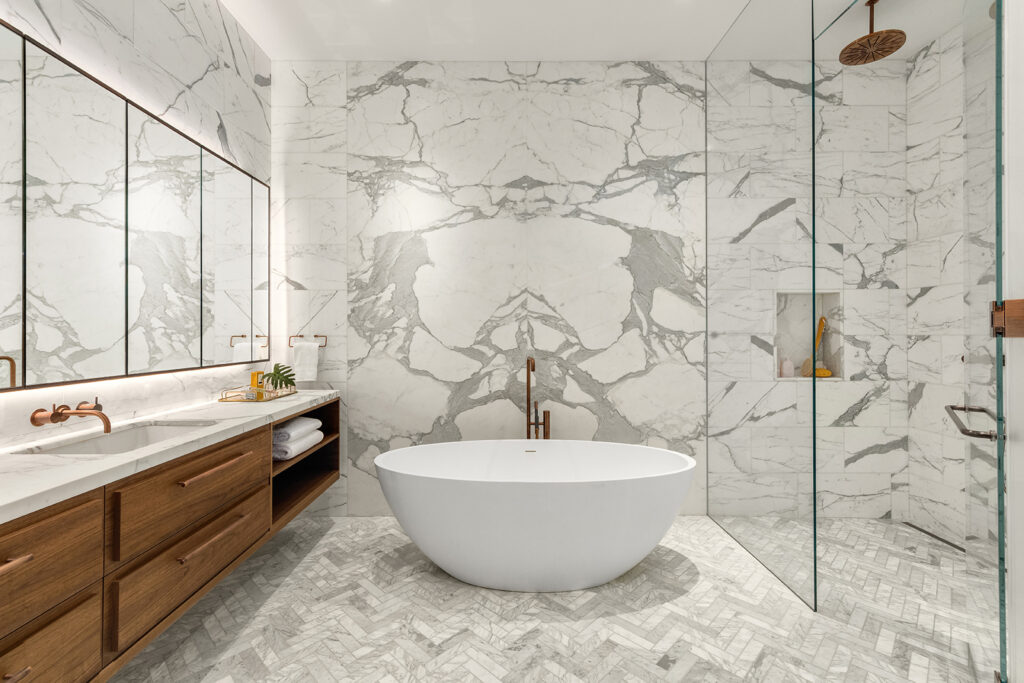
Free material samples and tub templates

After purchasing a new bathtub or even sprucing up an existing bath space, you may find that your bathtub doesn’t

The successful removal of a bathtub is an exercise in logistical planning and risk management, not merely a test of
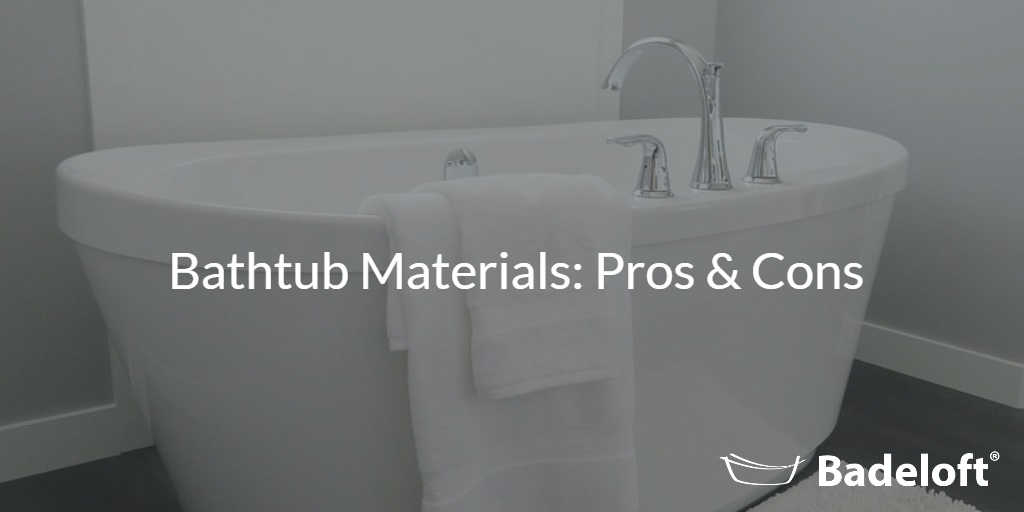
Picking out the right bathtub can be quite the daunting choice. Like choosing your first car, there are quite a
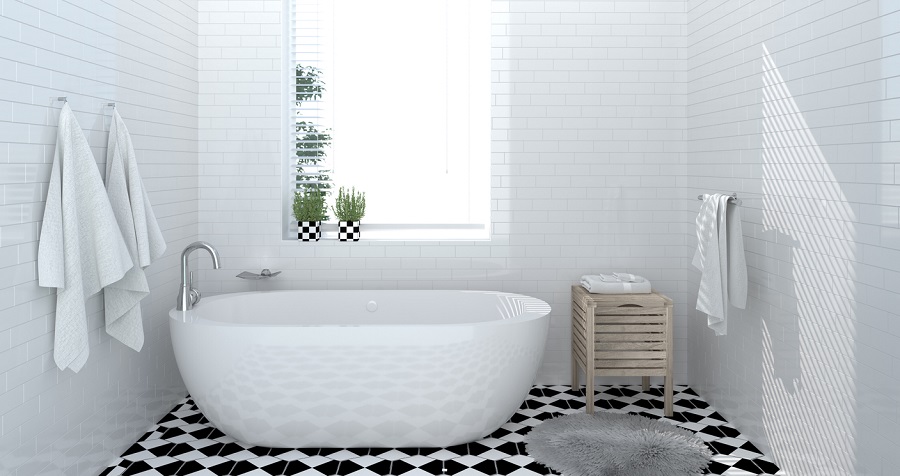
In 2025, homeowners can expect to spend between $1,500 and $8,000 on bathtub replacement, depending on the project’s scope. For
"*" indicates required fields
"*" indicates required fields
Request your free material sample below. By submitting, you agree to receive occasional product updates and offers from Badeloft. Unsubscribe anytime.
"*" indicates required fields
Thank you for your informative & detailed input on all types of tubs. Will make my choice much easier when I redo my master bathroom.
You’re welcome!
The tub is beautiful, however, the drain stop gasket does not seal and water drains out of the tub. Have been trying to contact the company for a replacement part with no results yet. Working with the plumber who will come up with a solution, at no doubt, great expense to me.
Best,
J. Concory
Dear Mr/Ms.
May I ask how to test the heat retention of materials, do you have a standard testing?
Thanks a lot.
Please email usa@badeloft.com with this question.
What is best material for an alcove bathtub?
We’re a bit bias but stone resin is in our opinion the best material you can use on a tub. https://www.badeloftusa.com/buying-guides/stone-resin/